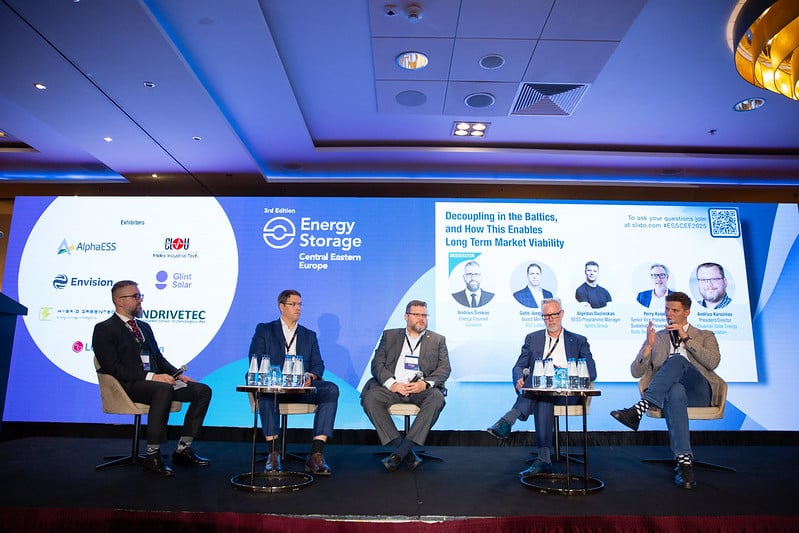
The Baltics is among the most attractive regions in Europe for battery energy storage system (BESS) investment right now, with the recent decoupling from Russia and increasing renewable energy use sending flexibility needs soaring.
That was the clear message from a panel discussion at Solar Media’s Energy Storage Summit Central and Eastern Europe 2025, a two-day event in Warsaw which kicked off yesterday (23 September).
Russia used to provide flexibility services to Baltics
“Both decoupling from Russia’s power system this February and also an increase in renewable generation are increasing demand for flexibility. Russia’s power system historically provided the Baltic power system with flexibility, and this has now been removed,” explained transmission system operator (TSO) AST Latvia’s board member Gatis Junghāns.
“In addition, during the past three or four years, generation capacity in the Baltic region increased by 60% almost exclusively from solar and wind generation. This is another layer which creates demand. Therefore, since February this year, three Baltic TSOs have been organising balancing capacity and the energy market, and the price levels in these markets speak for themselves. Demand is very high.”
Try Premium for just $1
- Full premium access for the first month at only $1
- Converts to an annual rate after 30 days unless cancelled
- Cancel anytime during the trial period
Premium Benefits
- Expert industry analysis and interviews
- Digital access to PV Tech Power journal
- Exclusive event discounts
Or get the full Premium subscription right away
Or continue reading this article for free
Fellow panellist Algirdas Ducinskas, BESS programme manager, Ignitis Group, echoed this. The firm recently ordered 291MW/582MWh of BESS from system integrator Rolls-Royce for three projects in Lithuania, scheduled for 2027 operation.
Ancillary service prices ‘through the roof’
“One strong signal for investors is that ancillary service markets are now going through the roof. But I think one of the key drivers, before synchronising with Europe, was the state aid scheme,” Ducinskas said.
“We had a call for state aid that was to reach 1.2 gigawatt hour. Now we have four gigawatt hours of projects that are awarded, and there are way more projects in the pipeline, and we have a second call.”
“We do have these strong price signals. Recently, price indexes reported by third parties have looked at the Baltics as the most attractive. If you have a battery project going online, the IRRs will be 20-30%, that’s big.”
“As developers, we will be observing how the market prices of ancillary services will change when the first commercially active BESS projects come online.”
Andrius Karazinas, president of the Lithuanian Solar Energy Association, similarly said that the first-movers will profit the most.
The point about ‘first commercially active’ projects is an important one. There is 200MW online in Lithuania but this is all from four projects that system integrator Fluence deployed for TSO Litgrid specifically to help with decoupling from Russia. These assets may well behave differently to private investor-backed ones coming online, like Ignitis’. The only other major project online in the Baltics is a 26.5MW/53.1MWh one from state-owned utility and power generator Eesti Energia.
Long-term risks in a relatively shallow market
Moderator Andrius Šimkus, energy counsel at law firm Sorainen, highlighted that there are still risks in the long-term because of the region’s smaller size. He pointed out that total energy consumption in the Baltics in 2024 was about one seventh of Poland’s, and there is limited heavy industry and new tech like data centres.
Ducinskas had similarly pointed out earlier that the ancillary service markets in the Baltics were relatively shallow, totalling around 830MW spread across FCR (30MW), aFRR (100MW) and mFRR (700MW) and that, as in most places, there was no clear long-term target for BESS deployment.
“We do see high return rates on these projects, but in general, the targets for where we will be going to evolve as a market, that’s a big question mark,” he said.
Addressing these points, AST Latvia’s Junghāns explained why there is still plenty of room for more flexibility assets to come online.
“So, this year, FCR prices are roughly two times more expensive in the Baltics than in Finland. mFRR prices are approximately four times higher than in the Finnish market, and aFRR prices are roughly 10 times more expensive than in the Finnish market,” he said.
“That shows there is a deficit; TSOs still have difficulties meeting these needs. Most capacity is from conventional power plants and those have limitations in meeting these needs. New BESS will replace these conventional resources, and then meet additional flexibility demand further down the line.”
“Energy market price signals in day-ahead and intra-day are also interesting; the duck curve and price spreads are becoming more pronounced every year. If you look at balancing energy market prices and PICASSO, you see high price volatility, sometimes reaching thousands of euros per megawatt-hour. This all indicates there is still a lot of room for more flexibility.”
